How to establish a Community Technology Partnership
Let's retire the endless magic bullets and solve problems together instead. Kim lays out a methodology for how we can start building technology by thinking about people, not products: and guess what, it's rooted in ✨ existing community networks ✨.
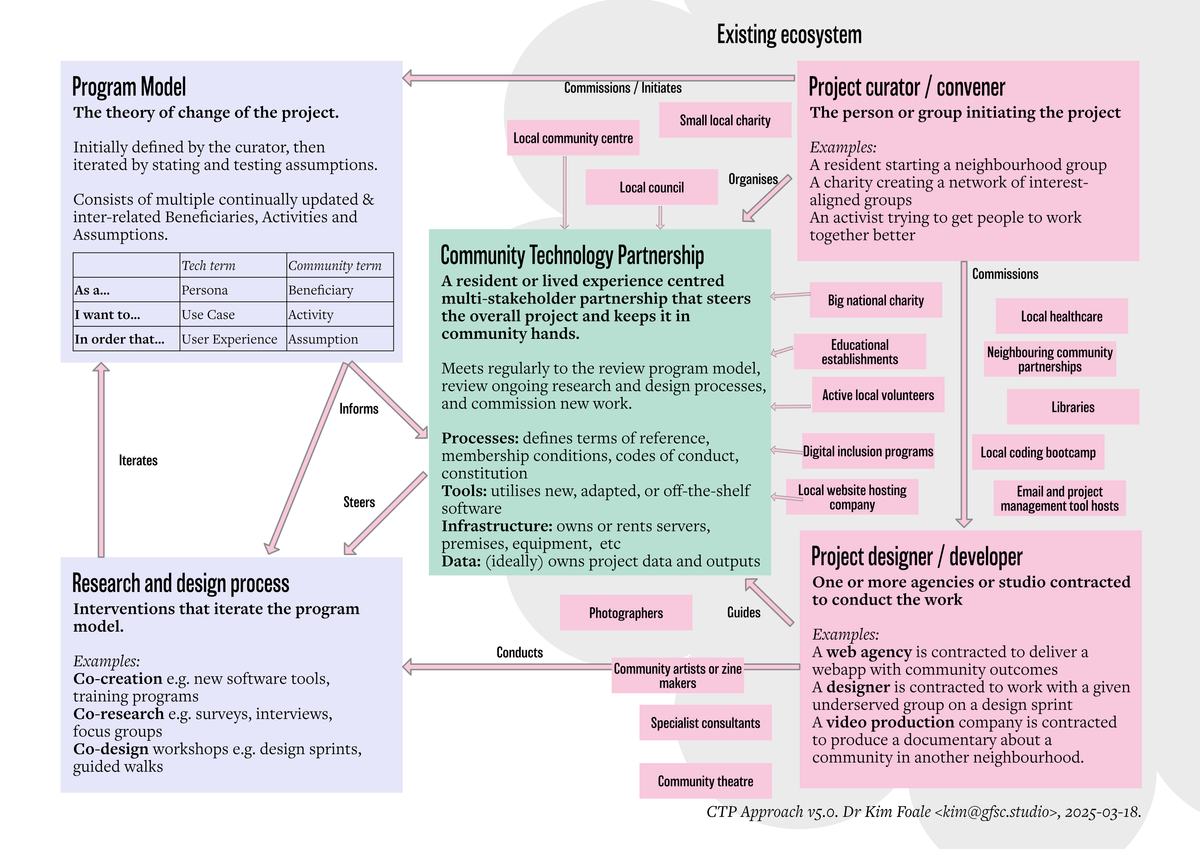
Selling generic solutions to specific problems is a key component of any empire.
What’s as big as a house, burns 20 liters of fuel every hour, puts out a shit-load of smoke and noise, and cuts an apple into three pieces? A Soviet machine made to cut apples into four pieces!
– Glukhov, Chernobyl (2019)
As the adage goes, “when you have a hammer, everything looks like a nail”. Or, in the case of the miners in the fantastic Chernobyl miniseries, when you have massive nationalised manufacturing, everything looks like an opportunity to create an over-engineered, hyperspecialised steam engine.
Two decades into the software-as-a-service-ification of everything, and a couple of years into inserting AI into everything whether we like it or not, things are probably much, much worse than they were in 80s communism. Now though, the apple-cutting-machines are in gigawatt data centres due to be powered by new build nuclear reactors and cooled by the planet's dwindling drinkable tap water supply, out of sight and out of mind for most of us in the West.
How community technology commissioning works now
This tendency to over-engineer is sadly, ubiquitous. How did it get like this? In a previous article I wrote about how technology isn't a magic wand, it's a treasure map. I think we are now so used to thinking of technology as set of magic bullets that we sort of know probably won't work, or just create new problems: this hilarious thread about someone trying to set up a smart home comes to mind. After 100s of magic bullets and our lives still being admin hell, only with more surveillance and logins than we ever dreamed existed, and somehow a dozen monthly fees for the privilege, the problems we are trying to solve have never been less clear.
The Community Technology Partnership (CTP) approach aims to be a route to go back to square one and work out what problems we're trying to fix in the first place. What methodology can we employ that ends up with the answer being a new knife and not a house-sized apple-cutting machine, but now with AI?
As someone whose been making websites for a couple of decades, I can confidently say that dissuading clients of this kind of overengineered solution is the least fun part of the job. In a regular client/studio build process, a client decides that what they need to fix their tech problems is a loosely defined ‘website’. Some poor soul, usually with no experience of such a thing, gets given the job of commissioning it, and generally creates a specification for by just asking everyone involved what they want and putting it in a big Google Doc. They then sent it out to tender for studios and run a competitive bidding process, and generally the winner of this will be the person who has experience doing websites that look most like the website that the commissioner has in their head, whether they work or not.
Builds typically take 6 months to a year, during which time there is generally no progress to see for the people in the space. Once it's done, there is generally no time put aside for training and no maintenance contract is set up as all the budget was spent. The site is updated over the first two weeks or so enthusiastically before life gets in the way and changes stop completely.
Within 18 months, all the staff involved in commissioning the site have moved on to new organisations and the new ones don't know how to log into the site, the last update was a year ago, and there might even be some suspicious links to Viagra and Rolexes popping up. Then someone says “we should really get funding to commission a new website, our current one sucks”... and repeat the whole cycle exactly as before. Iterate this a few times, and each organisation has an entire basement full of different machines designed to cut each different type of fruit, all running 24/7, and noone can remember how any of them work.
This process is not just wasteful, time consuming, terrible for the environment, and frustrating for everyone involved, it just completely elides questions that would be central to any non-tech project: who is this for? What do they want to do? What problems does it solve for them? What sense of ownership do people have over it? How do we measure when we've done it? Because people are constantly trying to fix all their tech problems in this panic state, ‘the website’ (or sometimes ‘the CRM’) becomes the ultimate boondoggle, a catchall site of magical thinking to fix all an organisations problems without defining what they are. Surely there's a better way.
What if we centred people and problems instead?
What if we started with meeting people where they're at, finding out their tech needs right now, and surfacing desirable social outcomes that we might want to automate? What if we forgot about making a website at all, or at least until we know exactly what it needs to do? What if we fixed the 100 tiny problems people had first – the tech equivalent of buying a couple dozen bikes instead of a new 4x4? We need an approach to commissioning technology that meets community needs and is owned, operated, and perhaps most importantly understood by the people using it.
It wasn't so long ago we used to own all our software on physical media that ran on computers that didn't change so much. Now we are renting month by month to get access to software running on other people's computers that we don't even know where they are in the world! It's no suprise people are struggling. We need to end our dependancy on corporate-owned technology which is not serving us (or society, or the planet!) created by some of the worst companies led by the worst people on Earth: Amazon, Meta, X.
Over our last 5 years' research with a diverse range of communities across the country, we've found that almost everyone is struggling with these digital basics: how to best use things like GSuite and Office 365 to work for you properly, how to create good forms and surveys, how to organise and promote events using digital tools, and learning what social media you actually need to be on and how to run it. Most importantly of all, we learnt how to make sure that all the outputs are understood, community owned, and that the community who commissions them can train itself to use them when we are gone.
Presenting: the Community Technology Partnership approach
OK, on to the question of how to actually do it. As part of our Work in Progress theme I'm presenting this as a draft to get as much input as possible. If this feels like a lot to parse at the moment, you're not alone! Over the coming weeks and months I'm going to work on making this as clear as possible and showing several worked examples, so if this makes sense to you now then GREAT, please let's chat, but equally if the themes discussed appeal but it's not quite making sense yet I'd love to talk to you too. (Side note but if there's any publishers reading this I think the end result of spelling this out and all the work that went into it is a book 👀 get in touch if this a thing you think you can help with?)
The goal of a CTP approach is to start from the problems being solved, not from the products we might buy to fix it. It is aimed to facilitate communities themselves coming to shared understandings of common problems that facilitate reuse, learning, adaptation and recycling. This was originally outlined in our 2020 journal paper; this is an attempt to create a "how to" guide to actually make one.
Instead of centring a website or tech build as the centre of the development process, we centre the community partnership it is for instead. Here's the most zoomed-out view. Yes it's a lot – I'll break each chunk down. Let's look at each of the parts in turn.
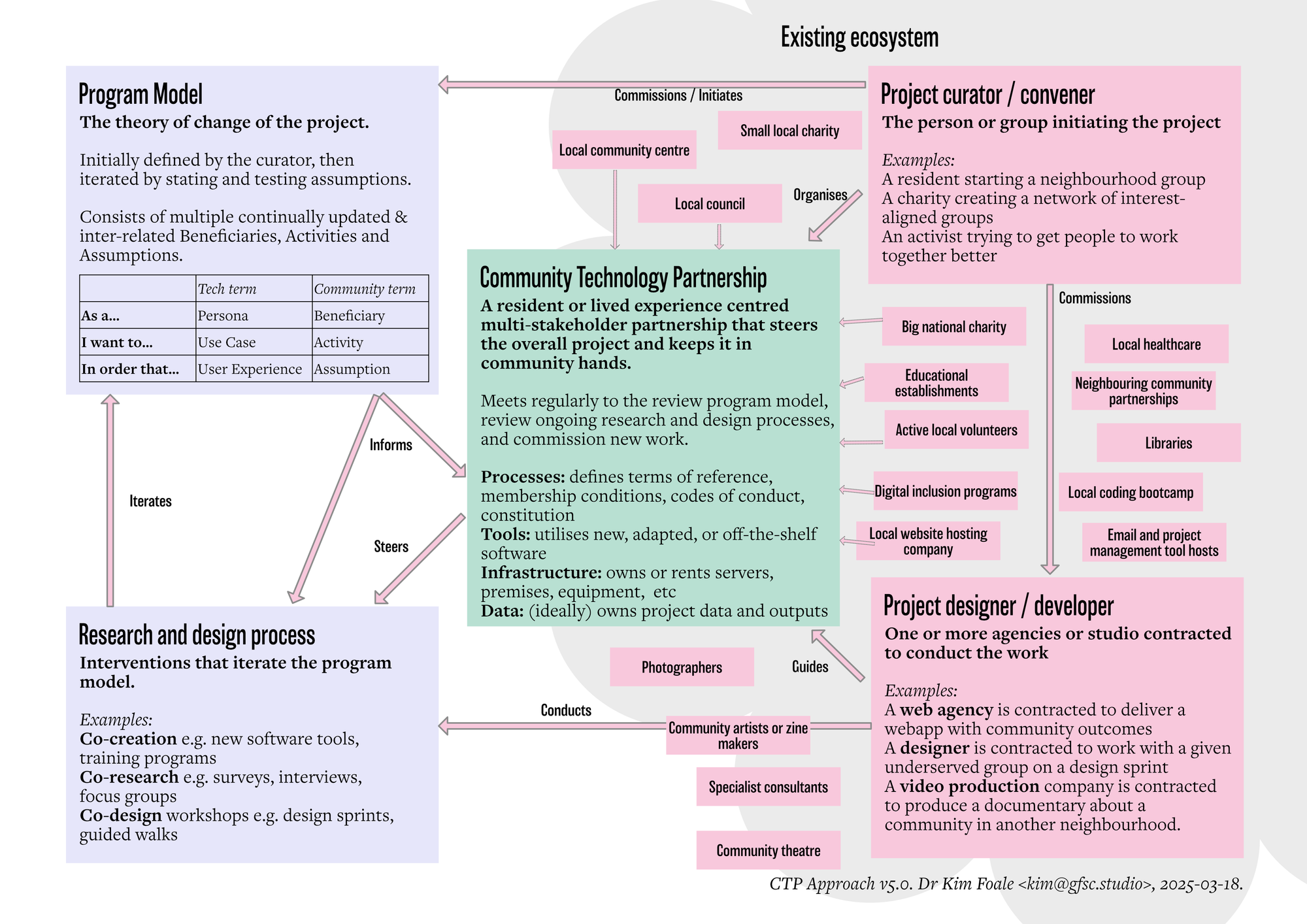
Project curator
Traditionally in a tech build process this is ‘the client’ – the one with the money, who gets to call the shots. It can also just be anyone starting a grassroots project on the ground. In a more ‘normal’ setup, this person does all or most of the research then hands over a completed brief to a studio, as discussed further up the article.
Shifting how we think about this role into being a curator of a social project instead of a commissioner of a tech product lets us acknowledge their plenipotentiary agency whilst making possible a shift of power as projects go on. At the end of the day its their money, something hard to come by for community projects: neither eliding it or centring it does us any favours, though. Pragmatically, someone has to take the lead and make creative decisions: our goal is not to prematurely over-democratise complex processes, but to create a framework for understanding things as they are now within this complete ecosystem.
Project designer
Traditionally, this is ‘the studio’ – the person who won the tender and got given the money and expected to fulfil a fixed brief for the client. This makes sense when the goal is simply designing products to sell to make a profit, but less well when the studio is itself a socially motivated organisation with opinions and experience of its own, and a track record working in both the type of labour and the area of social justice. Shifting the focus in this way moves us from a model that is based in competition to an approach that enables greater cooperation.
The typical studio / client relationship stops here, with the rest of the chart being simply people to glean research data from or sell to: it doesn't help that many projects that just do a lot of market research with poor people call themselves co-produced. The CTP approach recognises the entire existing design and technology infrastructure that surrounds a project, because there is rarely just one designer on any project but rather a succession of interventions over years.
Program model (aka Theory of Change)
A progam model is a description of the logic at the centre of a social intervention. Theories of change frequently get really bogged down in overcomplicating things. I propose just a simple three part approach that is quick to do and allows rapid iteration.
Here's a draft of one from a client I'm working with at the moment. The idea of this is to state the basic assumptions behind why are we bothering at all (assumptions), and then link then with the things you are already doing (activities) that you assume are helping you do this (they probably are because you're smart, but doing this helps lay out organisational logic in its barest terms).
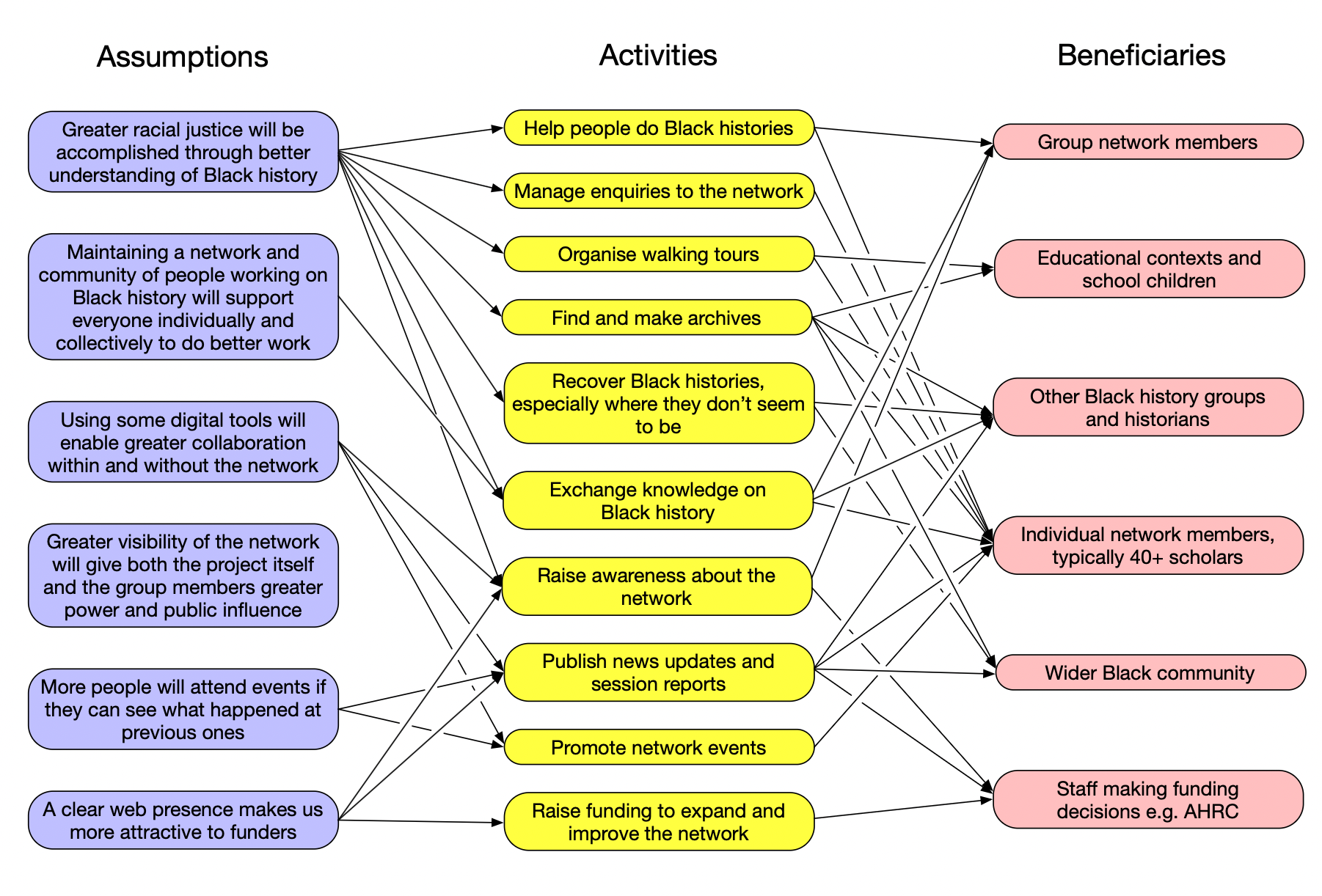
The CTP program model then simply suggests asking periodically if the assumption was correct, and then making some new assumptions and repeating the process.
This might seem overly basic to the person doing the activity but I can promise you having this discussion about why are doing it not only democratises organisational logic, but opens the door to ask if there's better ways to achieve the same things with less effort. For example, I can say that to me it's perfectly obvious that this blog is designed to encourage a new leftist praxis of pluralist making using technology as a method, but I can just as surely know that noone else here does probably (something I hope to explore in full with the other authors at a later date). Going though this chain of logic together will give us all a better understanding of the project, our role in it, and how we might want to go forwards. Simpler examples would simply ask everyone what they hope having a website will achieve at the outset: the answers may surprise you!
As a bonus, a program model allows for easier comparisons with other organistions to find shared activities that we may be able to collaborate on – how is still a bit of a work in progress, but this kind of diagram is already raising some “oh, I can help with that” -type win-win sychronicities as I'm developing this approach. For example, I frequently find that within project ecosystems there is an existing website that could use some love and be bought up to spec for the current brief – why don't we work on that instead?
Research and design process
All of this context sets up for a project designer to have a more expansive and social remit when intervening in any given context. Instead of starting from the assumption we need ‘a website’ that will be created to a pre-defined brief by a designer, we instead start from a description of a social reality that invites a range of interventions.
Maybe better things to make than a website would be: a set of posters; a social media campaign; some hands-on tech support for people in the network; a community feast and co-design session; improving tech that already exists; consolidating two or more data sources; adapting one or more off the shelf tools; starting a livestream, podcast, documentary, or blog; making a zine; and designing a process.
This also allows for tech to be reused, reduced and recycled, something we mentioned in our first ever post on this concept way back in 2017. In other domains it would be self explanatory to try and do as much as possible with existing resources before commissioning new work, however the culture and practice of the tech world demands constantly shipping new things.
The middle bit: the Community Technology Partnership
The centre of this diagram is the CTP itself. A CTP is a resident-led (or lived-experience-led, or both), multi-stakeholder parnership that already exists informally around any social issue, even if it's undefined, poorly defined, or dysfunctional. The goal of this approach is to make ‘coordination’ or ‘connective tissue’ easier, or in some cases possible at all. This is very much where the magic happens, and I will expand some examples of these in full in future posts.
How might this work in practice?
As a methodology-in-development, we've had a chance to try out some bits of this approach with some clients, but never from the start as a complete intervention from the ground up. GFSC studios's theory of change's ultimate goal is:
Work in partnership with people and organisations who share our social change goals to create tools and processes that help us live joyful, connected and capable lives in communities free from oppression.
The CTP approach attemps to create the conditions for communities of interest and place to own and operate their own means of production. Our fledgling example of this is The Trans Dimension. Right now we are living in a time of huge cognitive and political dissonance, where people are not able to live the ethics they want to. For example, generally every trans group is vehemently anti-capitalist and stands directly against big corporations, Meta specifically, and LLMs more generally. Despite this, we have overwhelmingly found that Instagram is the default method for both listing group information and primary contact, and groups don't have independant websites or sometimes even listed email contacts for groups. I am not going to outline all the ways this sucks here (it's a lot), but it's obviously not by political choice or user agency we have arrived here: much like Facebook, the cost of doing anything else is simply too high, and the economy of scale Meta operate over is too huge to compete with. Individuals are powerless to move: organising is hard enough as it is without adding in not using the primary medium people congretate on. Any technological resistance action must therefore be collective, or we don't have a chance. This is where a CTP approach comes in.
The Trans Dimension's CTP is a set of independant intellectual property (IP), an automated website and listing service, a support package for trans groups, and hopefully in the future a source of income as we add advertising. How much must Mark Zuckerberg make from showing adverts to trans people trying to find community and contact their friends? How much of our private discussion on there is scraped to improve their AI chat offerings? How much are they and will they collude with the state in future? It's almost impossible to know but we need to do better. A CTP is a concrete plan to move from an impossible situation to one where maybe, possibly, we have a chance of owning our own data, tools, processes, and means of production.
This was perhaps a lot of theory especially for people who don't work in the tech and design worlds. In my next article on this I'm going to write more about The Trans Dimension, and try and create a concrete plan for how others can follow the same process to make commons for their communities: be they bike clubs, comedy performers, climate campaigners, pro-palestine protestors, residents of any one neighbourhood, age friendly activity, and networks of libraries and leisure centres.

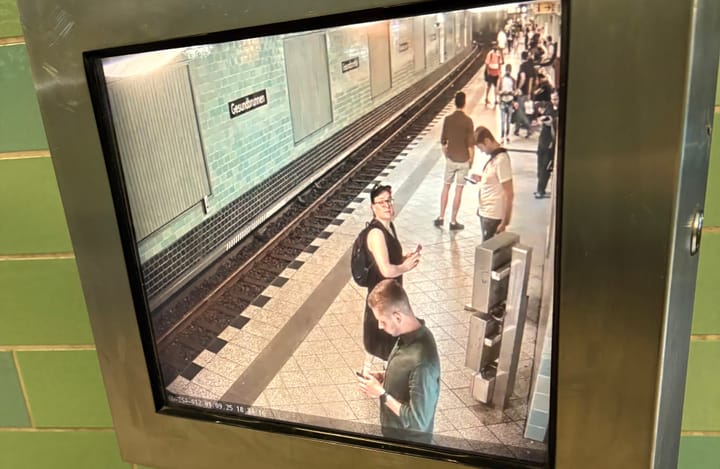

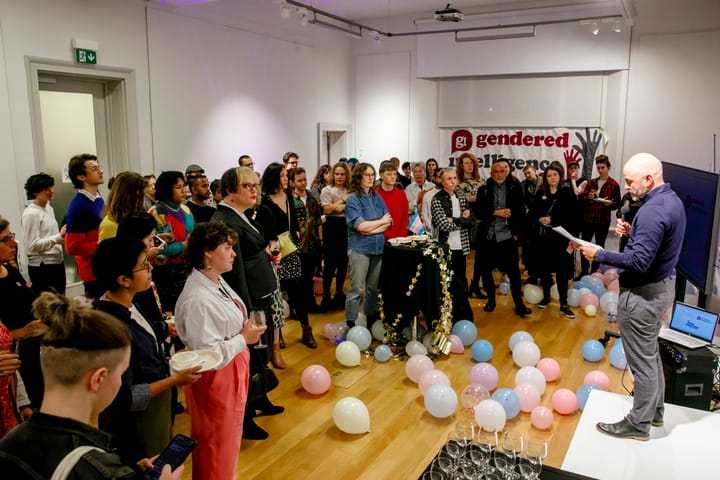
Comments ()